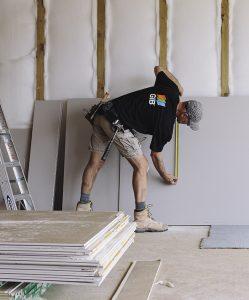Winstone Wallboards uses circular economy to reduce carbon emissions in plasterboard
-thinkstep-anz
 Circular economy thinking is helping Winstone Wallboards (WWB) reduce carbon in Aotearoa New Zealand’s built environment. Around 15% of our country’s greenhouse gas (carbon) emissions relate to our buildings. Knowing that construction waste contributes heavily to these emissions, WWB set itself a challenge.
Circular economy thinking is helping Winstone Wallboards (WWB) reduce carbon in Aotearoa New Zealand’s built environment. Around 15% of our country’s greenhouse gas (carbon) emissions relate to our buildings. Knowing that construction waste contributes heavily to these emissions, WWB set itself a challenge.
WWB manufactures plasterboard under the GIB® brand. It is New Zealand’s only manufacturer of this product. The company wanted to reduce plasterboard wasted in construction across New Zealand by 30% without changing the design of its product.
Its Designing out Waste programme (supported by the Ministry for the Environment, Canterbury Joint Waste Committee, Auckland Council, WasteMINZ, AUT and BRANZ) and circular economy practices have helped WWB reduce waste, emissions, costs and business risks and build relationships and the resilience in the industry.
The circular economy
The circular economy changes how we produce and consume goods. It designs out waste and pollution, keeps products and materials in use, and regenerates natural systems. In a circular economy, sending construction waste to landfill is a ‘leakage’ from the product’s ‘system’ (the processes involved in converting inputs to outputs).
Identifying five carbon ‘hotspots’ in plasterboard
 Our thinkstep-anz team helped WWB identify five ‘hotspots’ of greenhouse gas emissions (GHGs) for construction waste across their product’s lifecycle. The diagram below shows the emissions created when the manufacturer makes and transports its product to its customers, and when its customers use and dispose of the plasterboard.
Our thinkstep-anz team helped WWB identify five ‘hotspots’ of greenhouse gas emissions (GHGs) for construction waste across their product’s lifecycle. The diagram below shows the emissions created when the manufacturer makes and transports its product to its customers, and when its customers use and dispose of the plasterboard.
The emissions these activities release are examples of ‘embodied carbon’ in building products. The link between all these sources of emissions? Waste.
Circular economy: designing out waste on building sites
On an average residential building site, around 23% of all materials, including 700kg of plasterboard waste, end up in a skip bound for landfill (source: Wastage Rate Report (Construction Resources and Waste Platform), REBRI – BRANZ).
Much of this waste is created when builders cut down sheets of plasterboard. Even when things go to plan, this results in waste: they cannot typically reuse the offcuts. Add in mistakes such as cutting a board to the wrong size or damaging it during storage and the waste ratchets up fast.
To reduce these leakages, WWB now offers a wide range of plasterboard lengths and widths. Customers can order custom sizes if they buy 100 boards or more. This means they can use a size that is most efficient for their project and reduces or eliminates offcuts.
WWB is also pushing for changes across the industry. These include clauses in construction contracts to focus project teams on minimising waste, and encouraging modular design. The manufacturer also supports ‘materials logistics plans’ so that builders receive the right amount of materials at the right time. This reduces the risk of mislaying product, over-ordering, and damaging plasterboard stored on site.
Circular economy: designing out waste in manufacturing
High rates of construction waste mean building projects often use more plasterboard than they need to. As the industry reduces the amount of plasterboard it wastes, WWB can reduce the volume of plasterboard it needs to make and transport to support the same amount of building activity.
These activities help WWB maintain market position: it can adapt its production processes and offer customers value with ‘make to order’ plasterboard. Aotearoa New Zealand benefits too. We can construct more buildings from the same amount of plasterboard, with lower average carbon emissions.
Circular economy: keeping materials in use
The manufacturing process creates waste gypsum. Gypsum is a mineral that contains sulphur and calcium and improves soil structure.
WWB wanted to give this gypsum a ‘second life’. Its partnerships in Auckland, Bay of Plenty, Waikato, Nelson, Canterbury and Central Otago recycle gypsum for agricultural and horticultural uses. Instead of sending waste to landfill, WWB contributes to a circular, biological system.
The manufacturer will continue to extend circular economy in the coming year. When it opens its new plant in Tauriko, Tauranga, the company will be able to recycle waste plasterboard into new plasterboard. This is an example of a circular technical system.
How WWB’s business benefits
By reducing the factors that cause these leakages, WWB has reduced its greenhouse gas emissions too. These emissions include emissions in the natural gas the manufacturer uses to dry plasterboard, in the electricity, paper and gypsum it buys to make plasterboard, and in buildings around New Zealand.
By reducing its waste, the company pays lower landfill fees. It has reduced its risks by anticipating changes in government policy such as higher waste charges. WWB has built more resilience in the industry by increasing its capacity to meet its customers’ demand.
Circular economy helps WWB build relationships. Customers value the opportunity to make their plasterboard go further, spend less to dispose of their waste, and ‘buy more responsibly’. Employees appreciate being part of a business that is ‘doing the right thing’. The programme helps WWB meet its ESG (environmental, social and governance) targets and keep its investors happy.



